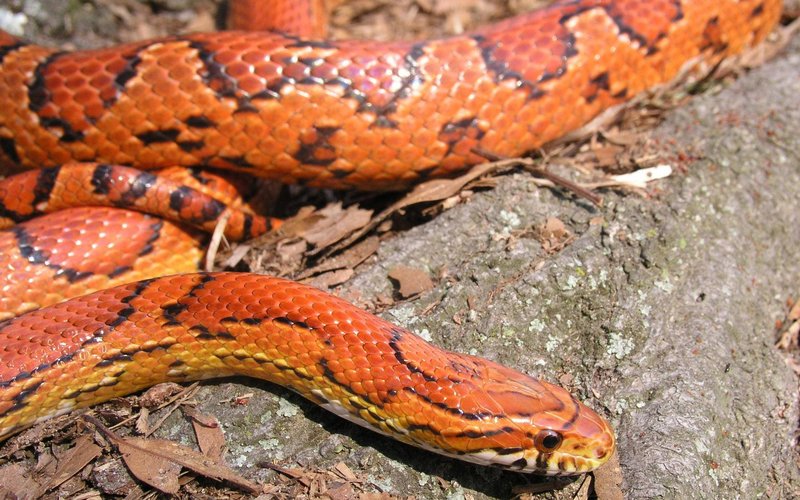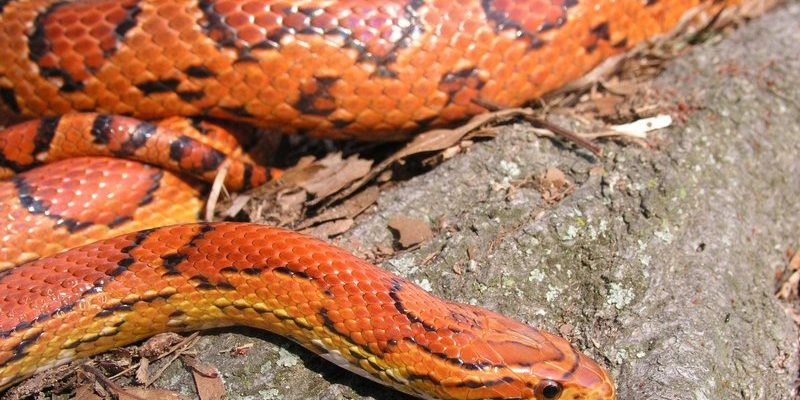
When you think about keeping a snake as a pet, the Corn Snake often comes to mind. These snakes are not just captivating in appearance, but they also have a reputation for being friendly and easy to care for—making them perfect for both beginners and seasoned reptile enthusiasts alike. They’ve been a popular choice for pet owners for decades, known for their striking colors and docile nature. It’s almost like having a living piece of art that you can hold and interact with!
You might be wondering where the name “Corn Snake” comes from. Well, it’s said to derive from their presence in cornfields, where they hunt for rodents. Imagine walking through a sunny field, the golden corn swaying in the breeze. It’s that same kind of place where these snakes thrive, blending into their surroundings while keeping a close eye on their next meal. Let’s dive deeper into what makes these snakes so special!
Physical Characteristics
Corn snakes are known for their stunning array of colors and patterns. Typically, they range from orange to reddish-brown, often adorned with darker blotches that give them a striking appearance. You might notice that their underbelly is a beautiful, creamy white, sometimes with hints of yellow. This colorful design not only makes them visually appealing but also serves a purpose—camouflage! In the wild, they can blend seamlessly with the ground and foliage, hiding from predators.
Adult corn snakes usually grow to be between 4 to 6 feet long, with some exceptional individuals reaching even longer. Their slender bodies are agile, allowing them to navigate through tight spaces and climb trees with ease. You could think of them as the gymnasts of the snake world! With their smooth scales and gentle disposition, handling a corn snake can be a rewarding experience.
Habitat and Distribution
Corn snakes are native to the southeastern United States. You’ll find them in a variety of habitats, from wooded areas to grasslands, and even in old agricultural fields. They thrive in regions where they can easily find shelter—think abandoned buildings or old barns, which provide warm nooks to hide away from both prey and predators.
In captivity, creating an ideal habitat for a corn snake is essential. A well-designed enclosure should mimic their natural environment. A simple 20-gallon tank can suffice for a young snake, while adults may need something larger. You’ll want to include hiding spots, a water bowl, and places for climbing. It’s important to keep the habitat warm, as they are ectothermic creatures, relying on their environment to regulate body temperature. You might consider a heat lamp or a heat mat to keep things cozy!
Diet and Feeding Habits
Corn snakes are carnivores, primarily feeding on small rodents like mice and rats in the wild. If you think about it, their hunting strategy is akin to a stealthy game of hide-and-seek. They often wait patiently for their prey to wander too close before striking with speed and agility, coiling around their meal to constrict it before swallowing it whole. If you’re picturing this in your mind, it’s quite an impressive sight!
As a pet owner, you’ll likely feed your corn snake pre-killed or frozen rodents. This is not only safer for the snake but also easier for you. Young corn snakes need to eat about once a week, while adults can be fed every 10-14 days. Keep an eye on your snake’s weight—overfeeding can lead to health issues. And remember, no matter how cute they are, don’t be tempted to offer them anything other than appropriately-sized rodents!
Behavior and Temperament
You might be surprised to learn that corn snakes have some personality! They are known for their calm demeanor, rarely exhibiting aggression. This makes them ideal pets for families or individuals looking for a friendly companion. If you’re thinking of bringing one into your home, you can expect a curious snake that loves to explore its surroundings. They can even recognize their owners over time, often becoming more comfortable being handled.
However, like any animal, they have their moods. Some days, your corn snake might prefer to stay hidden in its hiding spot, while on others, it’ll be slithering around its habitat with enthusiasm. It’s crucial to respect their feelings. If your snake seems agitated or stressed, give it some space. Remember, patience is key when bonding with your new reptilian friend!
Breeding Corn Snakes
Breeding corn snakes can be a fascinating experience but requires careful consideration. If you decide to breed them, it’s important to have good knowledge of their breeding habits and genetics. Female corn snakes lay between 10 to 30 eggs after mating, typically in June or July. These eggs are laid in a warm, humid nesting site, prompting them to incubate for about 60 days before hatching.
Once the eggs hatch, you’ll need to provide proper care for the hatchlings. It’s a bit like being a parent! Make sure they have their individual habitats ready, including small hiding spots and appropriate food. Young corn snakes will need to eat pinky mice every five days or so. And as they grow, you’ll be amazed at how quickly they change and develop their colors!
Common Health Issues
Like all pets, corn snakes can face health challenges, so it’s essential to be alert to their needs. One common issue is respiratory infections, which may be caused by improper humidity levels or temperature drops in their habitat. You might notice symptoms like wheezing or lethargy. In these cases, it’s crucial to consult a veterinarian who specializes in reptiles.
Other potential health problems include mites and scale rot, which can arise from poor husbandry practices or an unclean environment. Regular habitat cleaning and monitoring your snake’s health can help prevent these issues. Keeping a close eye on their shedding process is also important—if they’re having difficulty shedding, it may signal underlying health concerns.
Conservation Status
While corn snakes are popular as pets, it’s essential to be mindful of their status in the wild. Currently, they are not considered endangered and have a stable population in their native habitats. However, habitat destruction and environmental changes can threaten their numbers over time. By adopting a corn snake, you not only gain a wonderful pet but also help increase awareness about the importance of conservation.
Supporting reputable breeders and avoiding wild-caught snakes is vital. This practice helps protect natural populations and ensures that you’re bringing home a healthy animal that has been cared for properly. By being an informed and responsible pet owner, you are contributing to the overall health of the species.
Table of Corn Snake Facts
| Common Name: | Corn Snake |
| Scientific Name: | Pantheophis guttatus |
| Size: | 4 to 6 feet |
| Lifespan: | 10 to 15 years |
| Diet: | Rodents (mice, rats) |
| Habitat: | Woodlands, fields, and agricultural areas |
| Behavior: | Docile and curious |
Choosing a Corn Snake as a Pet
If you’ve made it this far, you might be seriously considering welcoming a corn snake into your home. Before you do, it’s important to evaluate your readiness. Ask yourself questions like—do you have the time and resources to provide proper care? Snakes may not need daily walks, but they do require regular habitat cleaning, feeding, and socialization.
When selecting a corn snake, look for reputable breeders or pet stores with good practices. Make sure your new companion is healthy, alert, and free of any visible issues. You can often pick the color and morph you like best—from classic orange to striking snow or lavender varieties. Remember, every corn snake is unique, and you’ll want to find one that resonates with you!
In conclusion, Corn Snakes are not just beautiful creatures; they are rewarding pets that can bring joy and fascination into your life. Their gentle nature, easy care requirements, and stunning colors make them one of the best choices for reptile enthusiasts. With the right knowledge, you can create a loving home for your corn snake and enjoy many adventures together.
FAQ
How often should I feed my corn snake?
Feeding frequency depends on your corn snake’s age and size. Young corn snakes generally need to be fed once a week, while adults can be fed every 10 to 14 days. Always ensure the prey item is appropriately sized—neither too large nor too small.
Can corn snakes live together?
It’s typically not recommended to house two corn snakes together. They can be territorial and may get into fights over space or food. If you want multiple snakes, it’s best to provide separate enclosures for each one.
What temperature should I maintain in my corn snake’s habitat?
The ideal temperature gradient for a corn snake’s habitat should be between 75°F to 85°F on the cool side and 85°F to 90°F on the warm side. Providing a basking spot with a heat lamp is essential for thermoregulation.
How can I tell if my corn snake is sick?
Signs of illness in corn snakes can include lethargy, loss of appetite, wheezing, or abnormal shedding. If you notice any of these symptoms, it’s best to consult a veterinarian who specializes in reptiles for an evaluation.
Do corn snakes require UVB lighting?
While corn snakes do not require UVB lighting like some reptiles, it can be beneficial for their overall health. Providing a natural day-night cycle with light and dark can help mimic their natural environment.
How long do corn snakes typically live?
Corn snakes can live around 10 to 15 years in captivity, with some individuals reaching even longer ages with proper care. Your love and attention can go a long way in ensuring a healthy and long life for your snake.
Are there different morphs of corn snakes?
Yes! Corn snakes come in various morphs, which are different color variations resulting from selective breeding. Popular morphs include the albino, snow, and blood varieties, each boasting unique and attractive appearances.
Can I handle my corn snake?
Yes, corn snakes are generally very docile and enjoy being handled. However, it’s best to allow your new pet some time to acclimate to its environment before handling it. Start with short sessions and gradually increase the time as it becomes more comfortable.
Is it safe to keep a corn snake with children?
Corn snakes can be safe pets for children, provided that they are supervised during handling. Teaching children how to respect the snake’s space and handle it gently can create a positive experience for both the pet and the child.
What should I do if my corn snake won’t eat?
If your corn snake refuses to eat, check the environmental conditions, such as temperature and humidity. Stress or illness can also affect their appetite. If the issue persists for more than a few weeks, it’s wise to consult a veterinarian to rule out health problems.

